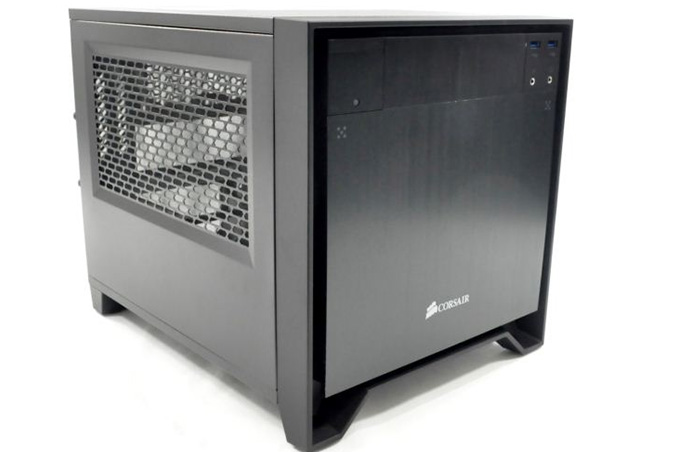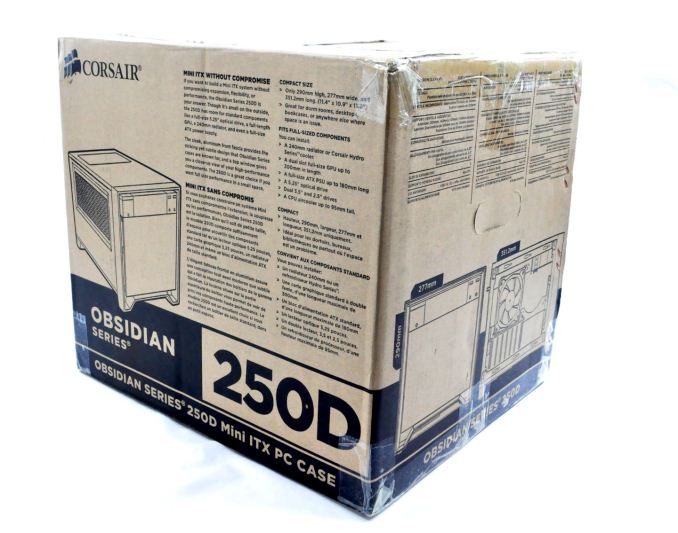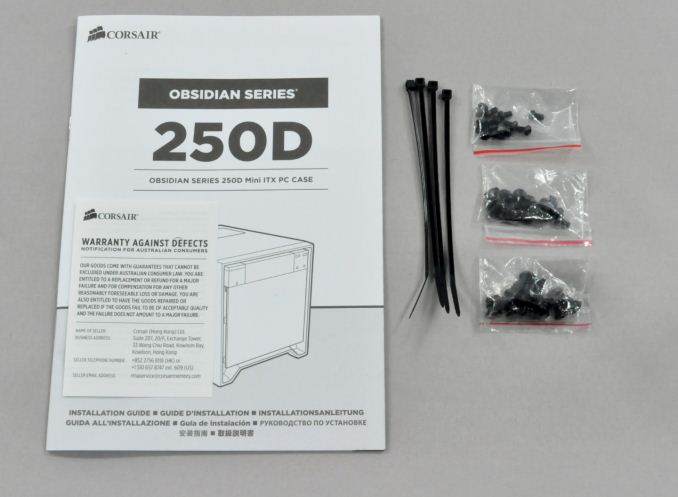Corsair Obsidian 250D Case Review
by E. Fylladitakis on January 21, 2014 12:00 PM EST- Posted in
- Cases/Cooling/PSUs
- Corsair
- Mini ITX
- Case

Ed: As this is his first review, we’d like to quickly introduce E. Fylladitakis. E. is taking over Cases & Cooling coverage as our newest editor, so this is the first of many articles you will see from him over the coming months
Corsair is a very well-known manufacturer among technology enthusiasts, and the company has been a supplier of premium memory modules for decades. During the past several years however, the company has successfully diversified into many segments of the market and today offers numerous products: computer cases, power supply units, air and liquid CPU coolers, solid-state drives, and gaming peripherals can all be found in Corsair's product ranks.
With the recent announcement of the Obsidian 250D, the company chose to start 2014 by joining the Mini ITX case fever, something most other large case designers and manufacturers have done recently. The Obsidian 250D however has not been designed with minimum proportions in mind; despite the Mini ITX format, it can still house very powerful gaming systems and advanced cooling solutions. The specifications of the case can be seen in the following table.
| Corsair Obsidian 250D | ||
| Motherboard Form Factor | Mini-ITX | |
| Drive Bays | External | 1 × 5.25" |
| Internal | 2 ×2.5" 2 × 3.5" | |
| Cooling | Front | 1×200 / 140 mm (140 mm included) |
| Rear | 2×80mm | |
| Top | - | |
| Side | 2 x 120 mm (1 × 120 mm included) | |
| Bottom | - | |
| I/O Port | 2x USB 3.0, 1x Headphone, 1x Mic | |
| Power Supply Size | ATX | |
| Clearances | HSF | ≈145 mm |
| PSU | - | |
| GPU | ≈295 mm | |
| Dimensions | 350 mm ×277 mm ×290 mm(D × W × H) | |
| Weight | ≈5kg | |
| Prominent Features | Aluminum front fascia and thick steel construction Top window for component visibility Thumbscrew backplate removal for PSU and hard drive access Easily removed dust filters on all intakes Simultaneously fit two 3.5”/2.5” drives, two 2.5” drives, one 5.25” drive, a full sized PSU, a 290mm long GPU, and a 240mm radiator Innovative three panel removal for sides and top panel, with thumbscrews Tons of cable routing tie downs for easy cable maintenance Tool free installation of all drives | |
| Price | ≈ 70 EUR / 89.99 USD | |
We received the Obsidian 250D inside a short, simple cardboard box that hints at the cubic shape of the case. Inside the box, we found the case packed between thick Styrofoam slabs and wrapped in a nylon bag, which is more than ample shipping protection for the small, lightweight case.
The bundle of the Obsidian 250D is sparse, with Corsair supplying only the absolutely necessary parts needed to fully assemble a system. We only found a manual, three small bags with black screws and a few black cable ties. At least some more cable ties and perhaps a couple of cable straps would be a nice addition. The bundle may be found in a cardboard box secured into one of the 3.5" trays.












52 Comments
View All Comments
lmcd - Tuesday, January 21, 2014 - link
It's pretty rare these days to find a board without USB 3.0. However I have seen one or two cheaper models unequipped. But again the niche is small and irrelevant in this case so while Spidey clearly is overreacting, the absence of an adapter isn't a big deal either.spidey81 - Tuesday, January 21, 2014 - link
I didn't mean to seem overreacting, but the reviewer is clearly biasing this case as an HTPC and not what it's geared toward. It's a gaming or enthusiast case. It is built to house high end components and cool them as such. It's not a low power HTPC nor suited for budget oriented builds. I agree with other commenters on here about the focus of the article and the intentions of the reviewer going into this review.vision33r - Tuesday, January 21, 2014 - link
Ugly case, the Bitfenix Prodigy is much better and just as flexible to mod if not better because of the drive cage design is better.dingetje - Tuesday, January 21, 2014 - link
yes, Bitfenix prodigy, phenom and colossus look nicer but are kinda big and, like the 250D, are not exactly budget.People who are looking for budget options should check out the cooler master elite 130 and the even smaller elite 110. They get my vote.
Bob Todd - Thursday, January 23, 2014 - link
The 130 looks like a nice update to the 120, glad they finally went all black with the front. The 120 was one of the better mITX case deals around. I picked up one for $40 and a second more recently (but before the 130 came out) for $35. Excellent case at those price points and plenty of room inside for a nice GPU without being too tall for HTPC usage.dingetje - Tuesday, January 21, 2014 - link
^ and I hope anandtech will review them :)smartthanyou - Tuesday, January 21, 2014 - link
Speaking for myself, it would be incredibly helpful to have some sort of frame of reference, in regards to size, when you show pictures of the exterior of the case. I am not sure what that should be, maybe a ruler laying horizontally and one vertically, or possibly using transparency to overlay pictures of a couple of competing cases.I would be curious how others feel but the exterior shots really don't give any sense of size.
kyuu - Tuesday, January 21, 2014 - link
I agree, a sense of scale would be very welcome. I can't really visualize how big/small this case really is without some context.wperry - Friday, January 24, 2014 - link
I had the same complaint/criticism with the review of the ASRock M8. Particularly with Mini ITX, size is very important factor and, for that, I need some sense of scale. NCASE had a really simple solution - put a soda can next to their case (or mock-up).J.Griff - Tuesday, January 21, 2014 - link
Fractal Design node 304 looks like it still remain king, nice try Corsair.